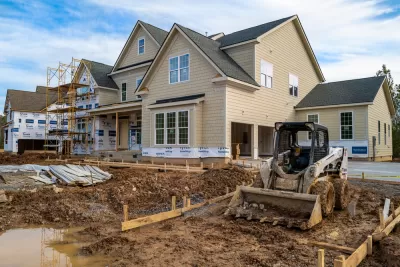Prohibiting single-family zoning alone won’t accomplish the needed transformation of the built environment in the United States.

A “spotlight on zoning practice” published this week by the American Planning Association (APA) goes into detail on some of the considerations in zoning codes other than land use that can contribute to housing equity. The “spotlight” provides insight into a longer piece written by John Zeanah for the May 2022 issue of Zoning Practice.
“Proposals to eliminate zoning districts that permit only single-family homes have dominated zoning reform discussions for the past five years. But focusing narrowly on getting rid of, so called, single-family-only zoning is unlikely to dramatically increase the supply of housing in most communities,” begins the post.
So what other zoning considerations can support missing middle housing and housing equity, according to Zeanah? The article lists two: 1) rightsizing bulk standards and 2) revisiting building codes.
On the first recommendation, Zeanah cites a 1991 report, “Not in My Backyard,” prepared by the Advisory Commission on Regulatory Barriers to Affordable Housing and presented to then Secretary of Housing and Urban Development Jack Kemp.
“Zeanah suggests planners should evaluate opportunities to relax bulk standards that make it difficult to fit multiple residences on a lot as well as those that require larger lots than the market would otherwise provide. These include standards that stipulate a minimum lot size or lot area per dwelling unit and those that establish a maximum building height.”
FULL STORY: Going Beyond "Use" Zoning to Promote Housing Equity

Maui's Vacation Rental Debate Turns Ugly
Verbal attacks, misinformation campaigns and fistfights plague a high-stakes debate to convert thousands of vacation rentals into long-term housing.

Planetizen Federal Action Tracker
A weekly monitor of how Trump’s orders and actions are impacting planners and planning in America.

San Francisco Suspends Traffic Calming Amidst Record Deaths
Citing “a challenging fiscal landscape,” the city will cease the program on the heels of 42 traffic deaths, including 24 pedestrians.

Defunct Pittsburgh Power Plant to Become Residential Tower
A decommissioned steam heat plant will be redeveloped into almost 100 affordable housing units.

Trump Prompts Restructuring of Transportation Research Board in “Unprecedented Overreach”
The TRB has eliminated more than half of its committees including those focused on climate, equity, and cities.

Amtrak Rolls Out New Orleans to Alabama “Mardi Gras” Train
The new service will operate morning and evening departures between Mobile and New Orleans.
Urban Design for Planners 1: Software Tools
This six-course series explores essential urban design concepts using open source software and equips planners with the tools they need to participate fully in the urban design process.
Planning for Universal Design
Learn the tools for implementing Universal Design in planning regulations.
Heyer Gruel & Associates PA
JM Goldson LLC
Custer County Colorado
City of Camden Redevelopment Agency
City of Astoria
Transportation Research & Education Center (TREC) at Portland State University
Jefferson Parish Government
Camden Redevelopment Agency
City of Claremont





























